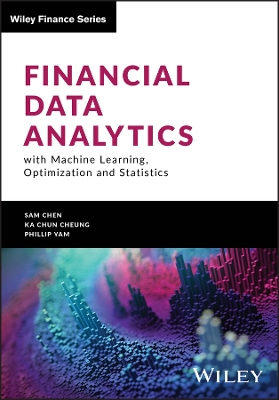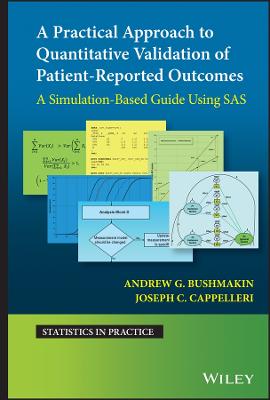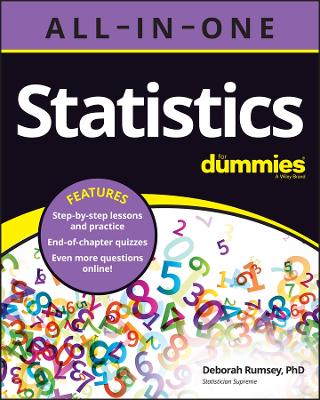Financial Data Analytics with Machine Learning, Optimization and Statistics
 -10%
portes grátis
-10%
portes grátis
Financial Data Analytics with Machine Learning, Optimization and Statistics
Cheung, Ka Chun; Chen, Sam; Yam, Phillip
John Wiley & Sons Inc
10/2024
816
Dura
Inglês
9781119863373
15 a 20 dias
Descrição não disponível.
About the Authors xvii
Foreword xix
Preface xxi
Acknowledgements xxv
Introduction 1
Development of Financial Data Analytics 1
Organization of the Book 5
References 7
Part One Data Cleansing and Analytical Models
Chapter 1 Mathematical and Statistical Preliminaries 11
1.1 Random Vector 12
1.2 Matrix Theory 16
1.3 Vectors and Matrix Norms 23
1.4 Common Probability Distributions 24
1.5 Introductory Bayesian Statistics 30
References 40
Chapter 2 Introduction to Python and R 41
2.1 What is Python? 41
2.2 What is R? 42
2.3 Package Management in Python and R 42
2.4 Basic Operations in Python and R 44
2.5 One-Way ANOVA and Tukey's HSD for Stock Market Indices 49
References 64
Chapter 3 Statistical Diagnostics of Financial Data 67
3.1 Normality Assumption for Relative Stock Price Changes 67
3.2 Student's t?-distribution for Stock Price Changes 76
3.3 Testing for Multivariate Normality 81
3.4 Sample Correlation Matrix 84
3.5 Empirical Properties of Stock Prices 86
3.A Appendix 93
References 97
Chapter 4 Financial Forensics 99
4.1 Benford's Law 99
4.2 Scaling Invariance and Benford's Law 101
4.3 Benford's Law in Business Reports 104
4.4 Benford's Law in Growth Figures 117
4.5 Zipf's Law 125
4.6 Zipf's Law and COVID-19 Figures 127
4.A Appendix 132
References 136
Chapter 5 Numerical Finance 139
5.1 Fundamentals of Simulation 139
5.2 Variance Reduction Technique 146
5.3 A Review of Financial Calculus and Derivative Pricing 158
*5.4 Greeks and their Approximations 179
References 199
Chapter 6 Approximation for Model Inference 201
6.1 EM Algorithm 201
6.2 mm Algorithm 216
*6.3 A Short Course on the Theory of Markov Chains 222
*6.4 Markov Chain Monte Carlo 236
*6.A Appendix 261
References 268
Chapter 7 Time-Varying Volatility Matrix and Kelly Fraction 271
7.1 Fluctuation of Volatilities 271
7.2 Exponentially Weighted Moving Average 275
7.3 ARIMA Time Series Model 277
7.4 ARCH and GARCH Models 291
*7.5 Kelly Fraction 317
7.6 Calendar Effects 330
*7.A Appendix 335
References 343
Chapter 8 Risk Measures, Extreme Values, and Copulae 345
8.1 Value-at-Risk and Expected Shortfall 345
8.2 Basel Accords and Risk Measures 348
8.3 Historical Simulation (Bootstrapping) 350
8.4 Statistical Model Building Approach 354
8.5 Use of Extreme Value Theory 356
8.6 Backtesting 359
8.7 Estimates of Expected Shortfall 364
8.8 Dependence Modelling via Copulae 369
*8.A Appendix 402
References 404
Part Two Linear Models
Chapter 9 Principal Component Analysis and Recommender Systems 409
9.1 US Zero-Coupon Rates 409
9.2 PCA Algorithm 411
9.3 Financial Interpretation of PCs for US Zero-Coupon Rates 417
9.4 PCA as an Eigenvalue Problem 421
9.5 Factor Models via PCA 422
9.6 Value-at-Risk via PCA 424
9.7 Portfolio Immunization 427
9.8 Facial Recognition via PCA 430
9.9 Non-Life Insurance via PCA 439
9.10 Investment Strategies using PCA 442
*9.11 Recommender System 447
*9.A Appendix 456
References 465
Chapter 10 Regression Learning 467
10.1 Simple and Multiple Linear Regression Models and Beyond 467
10.2 Polynomial Regression 473
10.3 Generalized Linear Models 478
10.4 Logistic Regression 484
10.5 Poisson Regression 497
10.6 Model Evaluation and Considerations in Practice 501
*10.7 Principal Component Regression 510
*10.A Appendix 518
References 522
Chapter 11 Linear Classifiers 525
11.1 Perceptron 526
11.2 Support Vector Machine 533
*11.A Appendix 545
References 567
Part Three Nonlinear Models
Chapter 12 Bayesian Learning 571
12.1 Simple Credibility Theory 571
*12.2 Bayesian Asymptotic Inference 573
12.3 Revisiting Polynomial Regression 575
12.4 Bayesian Classifiers 578
12.5 Comonotone-Independence Bayes Classifier (CIBer) 580
12.A Appendix 609
References 612
Chapter 13 Classification and Regression Trees, and Random Forests 613
13.1 Classification (Decision) Trees 613
*13.2 Concepts of Entropies 615
13.3 Information Gain 623
13.4 Other Impurity Measures for Information 626
13.5 Splitting Against Continuous Attributes 629
13.6 Overfitting in Classification Tree 630
13.7 Classification Trees in Python and R 633
13.8 Regression Trees 641
13.9 Random Forest 649
13.A Appendix 654
References 659
Chapter 14 Cluster Analysis 661
14.1 K-Means Clustering 661
14.2 K-Nearest Neighbour 694
*14.3 Kernel Regression 703
*14.A Appendix 714
References 725
Chapter 15 Applications of Deep Learning in Finance 727
15.1 Human Brains and Artificial Neurons 727
15.2 Feedforward Network 729
15.3 ANN with Linear Outputs 730
15.4 ANN with Logistic Outputs 737
15.5 Adaptive Learning Rate 740
15.6 Training Neural Networks via Backpropagation 742
15.7 Multilayer Perceptron 746
15.8 Universal Approximation Theorem 752
15.9 Long Short-Term Memory (LSTM) 754
References 764
Postlude 767
Index 769
Foreword xix
Preface xxi
Acknowledgements xxv
Introduction 1
Development of Financial Data Analytics 1
Organization of the Book 5
References 7
Part One Data Cleansing and Analytical Models
Chapter 1 Mathematical and Statistical Preliminaries 11
1.1 Random Vector 12
1.2 Matrix Theory 16
1.3 Vectors and Matrix Norms 23
1.4 Common Probability Distributions 24
1.5 Introductory Bayesian Statistics 30
References 40
Chapter 2 Introduction to Python and R 41
2.1 What is Python? 41
2.2 What is R? 42
2.3 Package Management in Python and R 42
2.4 Basic Operations in Python and R 44
2.5 One-Way ANOVA and Tukey's HSD for Stock Market Indices 49
References 64
Chapter 3 Statistical Diagnostics of Financial Data 67
3.1 Normality Assumption for Relative Stock Price Changes 67
3.2 Student's t?-distribution for Stock Price Changes 76
3.3 Testing for Multivariate Normality 81
3.4 Sample Correlation Matrix 84
3.5 Empirical Properties of Stock Prices 86
3.A Appendix 93
References 97
Chapter 4 Financial Forensics 99
4.1 Benford's Law 99
4.2 Scaling Invariance and Benford's Law 101
4.3 Benford's Law in Business Reports 104
4.4 Benford's Law in Growth Figures 117
4.5 Zipf's Law 125
4.6 Zipf's Law and COVID-19 Figures 127
4.A Appendix 132
References 136
Chapter 5 Numerical Finance 139
5.1 Fundamentals of Simulation 139
5.2 Variance Reduction Technique 146
5.3 A Review of Financial Calculus and Derivative Pricing 158
*5.4 Greeks and their Approximations 179
References 199
Chapter 6 Approximation for Model Inference 201
6.1 EM Algorithm 201
6.2 mm Algorithm 216
*6.3 A Short Course on the Theory of Markov Chains 222
*6.4 Markov Chain Monte Carlo 236
*6.A Appendix 261
References 268
Chapter 7 Time-Varying Volatility Matrix and Kelly Fraction 271
7.1 Fluctuation of Volatilities 271
7.2 Exponentially Weighted Moving Average 275
7.3 ARIMA Time Series Model 277
7.4 ARCH and GARCH Models 291
*7.5 Kelly Fraction 317
7.6 Calendar Effects 330
*7.A Appendix 335
References 343
Chapter 8 Risk Measures, Extreme Values, and Copulae 345
8.1 Value-at-Risk and Expected Shortfall 345
8.2 Basel Accords and Risk Measures 348
8.3 Historical Simulation (Bootstrapping) 350
8.4 Statistical Model Building Approach 354
8.5 Use of Extreme Value Theory 356
8.6 Backtesting 359
8.7 Estimates of Expected Shortfall 364
8.8 Dependence Modelling via Copulae 369
*8.A Appendix 402
References 404
Part Two Linear Models
Chapter 9 Principal Component Analysis and Recommender Systems 409
9.1 US Zero-Coupon Rates 409
9.2 PCA Algorithm 411
9.3 Financial Interpretation of PCs for US Zero-Coupon Rates 417
9.4 PCA as an Eigenvalue Problem 421
9.5 Factor Models via PCA 422
9.6 Value-at-Risk via PCA 424
9.7 Portfolio Immunization 427
9.8 Facial Recognition via PCA 430
9.9 Non-Life Insurance via PCA 439
9.10 Investment Strategies using PCA 442
*9.11 Recommender System 447
*9.A Appendix 456
References 465
Chapter 10 Regression Learning 467
10.1 Simple and Multiple Linear Regression Models and Beyond 467
10.2 Polynomial Regression 473
10.3 Generalized Linear Models 478
10.4 Logistic Regression 484
10.5 Poisson Regression 497
10.6 Model Evaluation and Considerations in Practice 501
*10.7 Principal Component Regression 510
*10.A Appendix 518
References 522
Chapter 11 Linear Classifiers 525
11.1 Perceptron 526
11.2 Support Vector Machine 533
*11.A Appendix 545
References 567
Part Three Nonlinear Models
Chapter 12 Bayesian Learning 571
12.1 Simple Credibility Theory 571
*12.2 Bayesian Asymptotic Inference 573
12.3 Revisiting Polynomial Regression 575
12.4 Bayesian Classifiers 578
12.5 Comonotone-Independence Bayes Classifier (CIBer) 580
12.A Appendix 609
References 612
Chapter 13 Classification and Regression Trees, and Random Forests 613
13.1 Classification (Decision) Trees 613
*13.2 Concepts of Entropies 615
13.3 Information Gain 623
13.4 Other Impurity Measures for Information 626
13.5 Splitting Against Continuous Attributes 629
13.6 Overfitting in Classification Tree 630
13.7 Classification Trees in Python and R 633
13.8 Regression Trees 641
13.9 Random Forest 649
13.A Appendix 654
References 659
Chapter 14 Cluster Analysis 661
14.1 K-Means Clustering 661
14.2 K-Nearest Neighbour 694
*14.3 Kernel Regression 703
*14.A Appendix 714
References 725
Chapter 15 Applications of Deep Learning in Finance 727
15.1 Human Brains and Artificial Neurons 727
15.2 Feedforward Network 729
15.3 ANN with Linear Outputs 730
15.4 ANN with Logistic Outputs 737
15.5 Adaptive Learning Rate 740
15.6 Training Neural Networks via Backpropagation 742
15.7 Multilayer Perceptron 746
15.8 Universal Approximation Theorem 752
15.9 Long Short-Term Memory (LSTM) 754
References 764
Postlude 767
Index 769
Este título pertence ao(s) assunto(s) indicados(s). Para ver outros títulos clique no assunto desejado.
Machine learning in finance; data analytics in finance; ML in insurance; financial data analytics; financial data analysis; mathematics for data analytics; quantitative methods with data analytics; data analysis in finance; statistics in finance; financial statistics; predictive analytics in finance; predictive analytics in insurance; machine learning applications in insurance; mathematics for machine learning; statistics for machine learning
About the Authors xvii
Foreword xix
Preface xxi
Acknowledgements xxv
Introduction 1
Development of Financial Data Analytics 1
Organization of the Book 5
References 7
Part One Data Cleansing and Analytical Models
Chapter 1 Mathematical and Statistical Preliminaries 11
1.1 Random Vector 12
1.2 Matrix Theory 16
1.3 Vectors and Matrix Norms 23
1.4 Common Probability Distributions 24
1.5 Introductory Bayesian Statistics 30
References 40
Chapter 2 Introduction to Python and R 41
2.1 What is Python? 41
2.2 What is R? 42
2.3 Package Management in Python and R 42
2.4 Basic Operations in Python and R 44
2.5 One-Way ANOVA and Tukey's HSD for Stock Market Indices 49
References 64
Chapter 3 Statistical Diagnostics of Financial Data 67
3.1 Normality Assumption for Relative Stock Price Changes 67
3.2 Student's t?-distribution for Stock Price Changes 76
3.3 Testing for Multivariate Normality 81
3.4 Sample Correlation Matrix 84
3.5 Empirical Properties of Stock Prices 86
3.A Appendix 93
References 97
Chapter 4 Financial Forensics 99
4.1 Benford's Law 99
4.2 Scaling Invariance and Benford's Law 101
4.3 Benford's Law in Business Reports 104
4.4 Benford's Law in Growth Figures 117
4.5 Zipf's Law 125
4.6 Zipf's Law and COVID-19 Figures 127
4.A Appendix 132
References 136
Chapter 5 Numerical Finance 139
5.1 Fundamentals of Simulation 139
5.2 Variance Reduction Technique 146
5.3 A Review of Financial Calculus and Derivative Pricing 158
*5.4 Greeks and their Approximations 179
References 199
Chapter 6 Approximation for Model Inference 201
6.1 EM Algorithm 201
6.2 mm Algorithm 216
*6.3 A Short Course on the Theory of Markov Chains 222
*6.4 Markov Chain Monte Carlo 236
*6.A Appendix 261
References 268
Chapter 7 Time-Varying Volatility Matrix and Kelly Fraction 271
7.1 Fluctuation of Volatilities 271
7.2 Exponentially Weighted Moving Average 275
7.3 ARIMA Time Series Model 277
7.4 ARCH and GARCH Models 291
*7.5 Kelly Fraction 317
7.6 Calendar Effects 330
*7.A Appendix 335
References 343
Chapter 8 Risk Measures, Extreme Values, and Copulae 345
8.1 Value-at-Risk and Expected Shortfall 345
8.2 Basel Accords and Risk Measures 348
8.3 Historical Simulation (Bootstrapping) 350
8.4 Statistical Model Building Approach 354
8.5 Use of Extreme Value Theory 356
8.6 Backtesting 359
8.7 Estimates of Expected Shortfall 364
8.8 Dependence Modelling via Copulae 369
*8.A Appendix 402
References 404
Part Two Linear Models
Chapter 9 Principal Component Analysis and Recommender Systems 409
9.1 US Zero-Coupon Rates 409
9.2 PCA Algorithm 411
9.3 Financial Interpretation of PCs for US Zero-Coupon Rates 417
9.4 PCA as an Eigenvalue Problem 421
9.5 Factor Models via PCA 422
9.6 Value-at-Risk via PCA 424
9.7 Portfolio Immunization 427
9.8 Facial Recognition via PCA 430
9.9 Non-Life Insurance via PCA 439
9.10 Investment Strategies using PCA 442
*9.11 Recommender System 447
*9.A Appendix 456
References 465
Chapter 10 Regression Learning 467
10.1 Simple and Multiple Linear Regression Models and Beyond 467
10.2 Polynomial Regression 473
10.3 Generalized Linear Models 478
10.4 Logistic Regression 484
10.5 Poisson Regression 497
10.6 Model Evaluation and Considerations in Practice 501
*10.7 Principal Component Regression 510
*10.A Appendix 518
References 522
Chapter 11 Linear Classifiers 525
11.1 Perceptron 526
11.2 Support Vector Machine 533
*11.A Appendix 545
References 567
Part Three Nonlinear Models
Chapter 12 Bayesian Learning 571
12.1 Simple Credibility Theory 571
*12.2 Bayesian Asymptotic Inference 573
12.3 Revisiting Polynomial Regression 575
12.4 Bayesian Classifiers 578
12.5 Comonotone-Independence Bayes Classifier (CIBer) 580
12.A Appendix 609
References 612
Chapter 13 Classification and Regression Trees, and Random Forests 613
13.1 Classification (Decision) Trees 613
*13.2 Concepts of Entropies 615
13.3 Information Gain 623
13.4 Other Impurity Measures for Information 626
13.5 Splitting Against Continuous Attributes 629
13.6 Overfitting in Classification Tree 630
13.7 Classification Trees in Python and R 633
13.8 Regression Trees 641
13.9 Random Forest 649
13.A Appendix 654
References 659
Chapter 14 Cluster Analysis 661
14.1 K-Means Clustering 661
14.2 K-Nearest Neighbour 694
*14.3 Kernel Regression 703
*14.A Appendix 714
References 725
Chapter 15 Applications of Deep Learning in Finance 727
15.1 Human Brains and Artificial Neurons 727
15.2 Feedforward Network 729
15.3 ANN with Linear Outputs 730
15.4 ANN with Logistic Outputs 737
15.5 Adaptive Learning Rate 740
15.6 Training Neural Networks via Backpropagation 742
15.7 Multilayer Perceptron 746
15.8 Universal Approximation Theorem 752
15.9 Long Short-Term Memory (LSTM) 754
References 764
Postlude 767
Index 769
Foreword xix
Preface xxi
Acknowledgements xxv
Introduction 1
Development of Financial Data Analytics 1
Organization of the Book 5
References 7
Part One Data Cleansing and Analytical Models
Chapter 1 Mathematical and Statistical Preliminaries 11
1.1 Random Vector 12
1.2 Matrix Theory 16
1.3 Vectors and Matrix Norms 23
1.4 Common Probability Distributions 24
1.5 Introductory Bayesian Statistics 30
References 40
Chapter 2 Introduction to Python and R 41
2.1 What is Python? 41
2.2 What is R? 42
2.3 Package Management in Python and R 42
2.4 Basic Operations in Python and R 44
2.5 One-Way ANOVA and Tukey's HSD for Stock Market Indices 49
References 64
Chapter 3 Statistical Diagnostics of Financial Data 67
3.1 Normality Assumption for Relative Stock Price Changes 67
3.2 Student's t?-distribution for Stock Price Changes 76
3.3 Testing for Multivariate Normality 81
3.4 Sample Correlation Matrix 84
3.5 Empirical Properties of Stock Prices 86
3.A Appendix 93
References 97
Chapter 4 Financial Forensics 99
4.1 Benford's Law 99
4.2 Scaling Invariance and Benford's Law 101
4.3 Benford's Law in Business Reports 104
4.4 Benford's Law in Growth Figures 117
4.5 Zipf's Law 125
4.6 Zipf's Law and COVID-19 Figures 127
4.A Appendix 132
References 136
Chapter 5 Numerical Finance 139
5.1 Fundamentals of Simulation 139
5.2 Variance Reduction Technique 146
5.3 A Review of Financial Calculus and Derivative Pricing 158
*5.4 Greeks and their Approximations 179
References 199
Chapter 6 Approximation for Model Inference 201
6.1 EM Algorithm 201
6.2 mm Algorithm 216
*6.3 A Short Course on the Theory of Markov Chains 222
*6.4 Markov Chain Monte Carlo 236
*6.A Appendix 261
References 268
Chapter 7 Time-Varying Volatility Matrix and Kelly Fraction 271
7.1 Fluctuation of Volatilities 271
7.2 Exponentially Weighted Moving Average 275
7.3 ARIMA Time Series Model 277
7.4 ARCH and GARCH Models 291
*7.5 Kelly Fraction 317
7.6 Calendar Effects 330
*7.A Appendix 335
References 343
Chapter 8 Risk Measures, Extreme Values, and Copulae 345
8.1 Value-at-Risk and Expected Shortfall 345
8.2 Basel Accords and Risk Measures 348
8.3 Historical Simulation (Bootstrapping) 350
8.4 Statistical Model Building Approach 354
8.5 Use of Extreme Value Theory 356
8.6 Backtesting 359
8.7 Estimates of Expected Shortfall 364
8.8 Dependence Modelling via Copulae 369
*8.A Appendix 402
References 404
Part Two Linear Models
Chapter 9 Principal Component Analysis and Recommender Systems 409
9.1 US Zero-Coupon Rates 409
9.2 PCA Algorithm 411
9.3 Financial Interpretation of PCs for US Zero-Coupon Rates 417
9.4 PCA as an Eigenvalue Problem 421
9.5 Factor Models via PCA 422
9.6 Value-at-Risk via PCA 424
9.7 Portfolio Immunization 427
9.8 Facial Recognition via PCA 430
9.9 Non-Life Insurance via PCA 439
9.10 Investment Strategies using PCA 442
*9.11 Recommender System 447
*9.A Appendix 456
References 465
Chapter 10 Regression Learning 467
10.1 Simple and Multiple Linear Regression Models and Beyond 467
10.2 Polynomial Regression 473
10.3 Generalized Linear Models 478
10.4 Logistic Regression 484
10.5 Poisson Regression 497
10.6 Model Evaluation and Considerations in Practice 501
*10.7 Principal Component Regression 510
*10.A Appendix 518
References 522
Chapter 11 Linear Classifiers 525
11.1 Perceptron 526
11.2 Support Vector Machine 533
*11.A Appendix 545
References 567
Part Three Nonlinear Models
Chapter 12 Bayesian Learning 571
12.1 Simple Credibility Theory 571
*12.2 Bayesian Asymptotic Inference 573
12.3 Revisiting Polynomial Regression 575
12.4 Bayesian Classifiers 578
12.5 Comonotone-Independence Bayes Classifier (CIBer) 580
12.A Appendix 609
References 612
Chapter 13 Classification and Regression Trees, and Random Forests 613
13.1 Classification (Decision) Trees 613
*13.2 Concepts of Entropies 615
13.3 Information Gain 623
13.4 Other Impurity Measures for Information 626
13.5 Splitting Against Continuous Attributes 629
13.6 Overfitting in Classification Tree 630
13.7 Classification Trees in Python and R 633
13.8 Regression Trees 641
13.9 Random Forest 649
13.A Appendix 654
References 659
Chapter 14 Cluster Analysis 661
14.1 K-Means Clustering 661
14.2 K-Nearest Neighbour 694
*14.3 Kernel Regression 703
*14.A Appendix 714
References 725
Chapter 15 Applications of Deep Learning in Finance 727
15.1 Human Brains and Artificial Neurons 727
15.2 Feedforward Network 729
15.3 ANN with Linear Outputs 730
15.4 ANN with Logistic Outputs 737
15.5 Adaptive Learning Rate 740
15.6 Training Neural Networks via Backpropagation 742
15.7 Multilayer Perceptron 746
15.8 Universal Approximation Theorem 752
15.9 Long Short-Term Memory (LSTM) 754
References 764
Postlude 767
Index 769
Este título pertence ao(s) assunto(s) indicados(s). Para ver outros títulos clique no assunto desejado.
Machine learning in finance; data analytics in finance; ML in insurance; financial data analytics; financial data analysis; mathematics for data analytics; quantitative methods with data analytics; data analysis in finance; statistics in finance; financial statistics; predictive analytics in finance; predictive analytics in insurance; machine learning applications in insurance; mathematics for machine learning; statistics for machine learning







